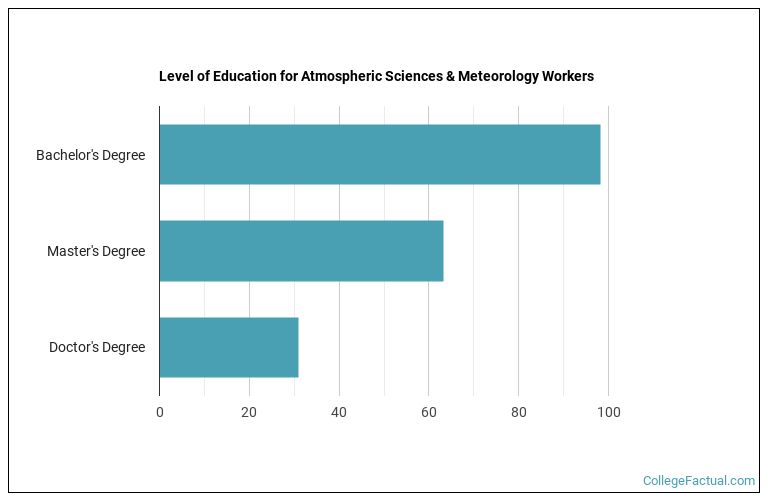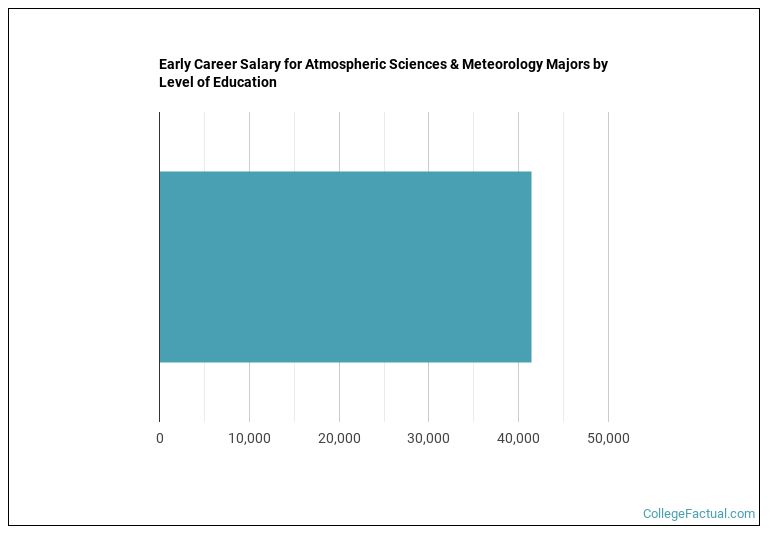 by our College Data Analytics Team
by our College Data Analytics TeamAre you fascinated by storms and weather? Do you want to learn how to predict climate changes? Consider a degree in Atmospheric Sciences and Meteorology.
A degree in this field will allow you to study the climate, the gases that make up the atmosphere, and weather. You will take classes in physics, chemistry, meteorology, climatology, computer science, calculus, and other science courses to help you not only predict the weather, but also learn how to improve air quality, reduce pollution, and help find new sources of energy.
Along with the option to major in Atmospheric Sciences and Meteorology, students also have the choice to major in areas of specialization including Atmospheric Chemistry and Climatology, Atmospheric Physics and Dynamics, and Meteorology.
In 2021-2022, atmospheric sciences & meteorology was the 227th most popular major nationwide with 1,183 degrees awarded. Our 2025 Best Atmospheric Sciences & Meteorology Schools ranking analyzes 29 of these schools to determine the best overall colleges for atmospheric sciences & meteorology students. Explore this or one of our many other custom meteorology rankings further below.
Since you will be required to perform advanced calculations, a strong background in mathematics is necessary for this field. You should be prepared to employ formulas to collect data on the atmosphere, air pressure, and temperature. Critical thinking skills will help you analyze this data and make climate and weather predictions while strong communication skills will allow you to explain your findings and predictions.
Atmospheric Scientists and Meteorologists often work fulltime jobs. However, these jobs don't always have typical work hours. Scientists must be watching the weather 24 hours a day even on weekends and holidays. Professionals often work on a rotating schedule to ensure conditions are constantly monitored. Longer and more irregular hours may occur during times of severe weather.
While a bachelor's degree will allow students to work in the Atmospheric Sciences and Meteorology field, those who wish to perform research need a master's degree at minimum. An advanced degree will also allow student to find better employment opportunities with better pay and the potential for advancement.
New students will need to have completed high school or a GED program and each school will have their own minimum GPA and SAT/ACT test requirements. Once you obtain your degree, additional meteorology certifications required to pursue a career in this field.
Meteorology degree levels vary. You can get anything from a in atmospheric sciences & meteorology to the highest meteorology degree, a . Atmospheric Sciences & Meteorology programs can take anywhere between one to four or more years for a full-time student to complete.
| Degree | Credit Requirements | Typical Program Length |
|---|---|---|
| Associate Degree | 60-70 credits | 2 years |
| Bachelor’s Degree | 120 credits | 4 years |
| Master’s Degree | 50-70 credits | 1-3 years |
| Doctorate | Program required coursework including thesis or dissertation | At least 4 years |
A master's degree is the most common level of education achieved by those in careers related to meteorology, with approximately 31.2% of workers getting one. Find out other typical degree levels for meteorology workers below.
| Level of Education | Percentage of Workers |
|---|---|
| Master’s Degree | 33.4% |
| Bachelor’s Degree | 25.4% |
| Doctoral Degree | 24.8% |
| Post-Doctoral Training | 9.4% |
| Post-Baccalaureate Certificate | 4.7% |
63.3% of meteorology workers have at least a master's. See the chart below for the most common degree level workers in atmospheric sciences & meteorology have received.

The education level required is different depending on the meteorology career you are seeking.
Most Atmospheric and Meteorology graduates work at the many weather stations throughout the country monitoring weather and predicting storms. Other graduates work for the government as part of the National Weather Service or the U.S. Department of Defense. Broadcast Meteorology is another career option. Atmospheric and Meteorology graduates not only predict weather, but are helping protect the environment by finding jobs in private industries interested in improving air quality, reducing pollution, or other environment protection services.
With the field growing at an average pace, graduates should be able to find jobs after graduation, specifically in private industry. Those willing to relocate may have a better chance of landing a well-paying job.
Want a job when you graduate with your meteorology degree? Atmospheric Sciences & Meteorology careers are expected to grow 10.2% between 2016 and 2026.
The following options are some of the most in-demand careers related to atmospheric sciences & meteorology.
| Occupation Name | Projected Jobs | Expected Growth |
|---|---|---|
| Natural Sciences Managers | 62,300 | 9.9% |
| Atmospheric, Earth, Marine, and Space Sciences Professors | 14,400 | 9.9% |
| Atmospheric and Space Scientists | 11,700 | 12.5% |
Recently graduated atmospheric sciences & meteorology students earned an average of $41,403 in <nil>. Earnings can range from as low as $34,361 to as high as $44,270. As you might expect, salaries for meteorology graduates vary depending on the level of education that was acquired.

Salaries for atmospheric sciences & meteorology graduates can vary widely by the occupation you choose as well. The following table shows the top highest paying careers meteorology grads often go into.
| Occupation Name | Median Average Salary |
|---|---|
| Natural Sciences Managers | $139,680 |
| Atmospheric, Earth, Marine, and Space Sciences Professors | $101,890 |
| Atmospheric and Space Scientists | $95,580 |
With over 216 different meteorology degree programs to choose from, finding the best fit for you can be a challenge. Fortunately you have come to the right place. We have analyzed all of these schools to come up with hundreds of unbiased meteorology school rankings to help you with this.
One of 8 majors within the Physical Sciences area of study, Atmospheric Sciences & Meteorology has other similar majors worth exploring.
| Major | Annual Graduates |
|---|---|
| General Atmospheric Sciences & Meteorology | 840 |
| Meteorology | 289 |
| Other Atmospheric Sciences & Meteorology | 44 |
| Atmospheric Chemistry & Climatology | 8 |
| Atmospheric Physics & Dynamics | 2 |
| Related Major | Annual Graduates |
|---|---|
| Chemistry | 20,985 |
| Physics | 13,447 |
| Geological & Earth Sciences | 8,124 |
| General Physical Sciences | 3,141 |
| Astronomy & Astrophysics | 1,396 |